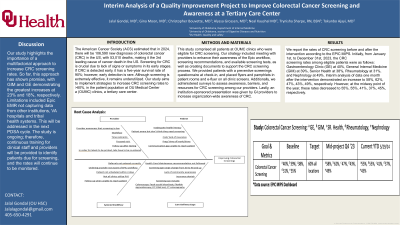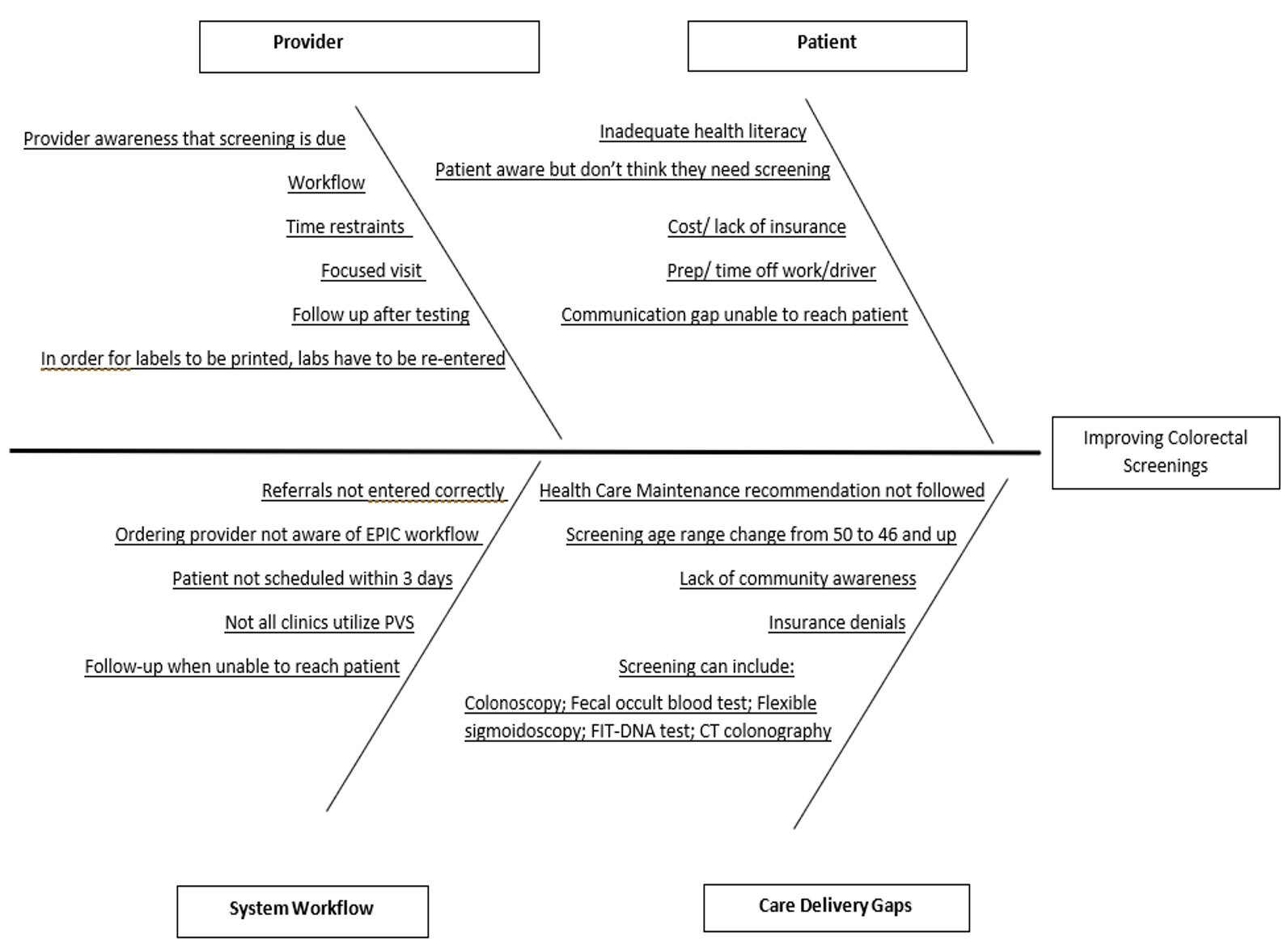Sunday Poster Session
Category: Colorectal Cancer Prevention
P0404 - Interim Analysis of a Quality Improvement Project to Improve Colorectal Cancer Screening and Awareness at a Tertiary Care Center
Sunday, October 27, 2024
3:30 PM - 7:00 PM ET
Location: Exhibit Hall E

Has Audio

Jalal Gondal, MD
University of Oklahoma Health Sciences Center
Oklahoma City, OK
Presenting Author(s)
Jalal Gondal, MD1, Gina Moon, MD1, Christopher Bouvette, MD1, Alyssa Grossen, MD2, Neal Kaushal, MD, MBA1, Trynisha Sharpe, RN, BSN3, Tokunbo Ajayi, MD4
1University of Oklahoma Health Sciences Center, Oklahoma City, OK; 2University of Oklahoma College of Medicine, Oklahoma City, OK; 3Oklahoma University Health Sciences Center, Oklahoma City, OK; 4University of Oklahoma Health Sciences Center, Oklahoma city, OK
Introduction: The American Cancer Society (ACS) estimated that in 2024, there will be 106,590 new diagnoses of colorectal cancer (CRC) in the US, with 53,010 deaths, making it the 3rd leading cause of cancer death in the US. Screening for CRC is crucial due to lack of signs or symptoms in its early stages. If CRC is detected early, it has a five-year survival rate of 90%; however, early detection is rare. Although screening is extremely effective, it remains underutilized. Our study aims to implement strategies to increase CRC screening rates to >60%, in the patient population at OU Medical Center (OUMC) clinics, a tertiary care center.
Methods: This study comprised all patients at OUMC clinics who were eligible for CRC screening. Our strategy included meeting with providers to enhance their awareness of the Epic workflow, screening recommendations, and available screening tests, as well as creating documents to support the CRC screening process. We provided patients with a preventive screenings questionnaire at check-in, and placed flyers and pamphlets in patient rooms and e-flyer on all clinic screens. Additionally, we administered surveys to assess awareness, barriers, and resources for CRC screening among our providers. Lastly, an institution-sponsored presentation was given by GI providers to increase organization-wide awareness of CRC.
Results: We report the rates of CRC screening before and after the intervention according to the EPIC MIPS. Initially, from January 1st, to December 31st, 2023, the CRC screening rates among eligible patients were as follows: Gastroenterology Clinic (GE) at 40%, General Internal Medicine (GIM) at 39%, Senior Healthat 38%, Rheumatology at 31%, and Nephrology at 49%. Interim analysis of data one month after the intervention demonstrated an increase to 58%, 62%, 47%, 43%, 49%, respectively. However, at the midway point of the year, these rates decreased to 55%, 55%, 41%, 37%, 45%, respectively.
Discussion: Our study highlights the importance of a multifactorial approach to increase CRC screening rates. So far, this approach has shown promise, with GIM and GE demonstrating the greatest increases at 23% and 18%, respectively. Limitations included Epic EMR not capturing data from other institutions, VA hospitals and tribal health systems. This will be addressed in the next PDSA cycle. The study is ongoing; therefore, continuous training for clinical staff and providers will be provided to identify patients due for screening, and the rates will continue to be monitored.

Disclosures:
Jalal Gondal, MD1, Gina Moon, MD1, Christopher Bouvette, MD1, Alyssa Grossen, MD2, Neal Kaushal, MD, MBA1, Trynisha Sharpe, RN, BSN3, Tokunbo Ajayi, MD4. P0404 - Interim Analysis of a Quality Improvement Project to Improve Colorectal Cancer Screening and Awareness at a Tertiary Care Center, ACG 2024 Annual Scientific Meeting Abstracts. Philadelphia, PA: American College of Gastroenterology.
1University of Oklahoma Health Sciences Center, Oklahoma City, OK; 2University of Oklahoma College of Medicine, Oklahoma City, OK; 3Oklahoma University Health Sciences Center, Oklahoma City, OK; 4University of Oklahoma Health Sciences Center, Oklahoma city, OK
Introduction: The American Cancer Society (ACS) estimated that in 2024, there will be 106,590 new diagnoses of colorectal cancer (CRC) in the US, with 53,010 deaths, making it the 3rd leading cause of cancer death in the US. Screening for CRC is crucial due to lack of signs or symptoms in its early stages. If CRC is detected early, it has a five-year survival rate of 90%; however, early detection is rare. Although screening is extremely effective, it remains underutilized. Our study aims to implement strategies to increase CRC screening rates to >60%, in the patient population at OU Medical Center (OUMC) clinics, a tertiary care center.
Methods: This study comprised all patients at OUMC clinics who were eligible for CRC screening. Our strategy included meeting with providers to enhance their awareness of the Epic workflow, screening recommendations, and available screening tests, as well as creating documents to support the CRC screening process. We provided patients with a preventive screenings questionnaire at check-in, and placed flyers and pamphlets in patient rooms and e-flyer on all clinic screens. Additionally, we administered surveys to assess awareness, barriers, and resources for CRC screening among our providers. Lastly, an institution-sponsored presentation was given by GI providers to increase organization-wide awareness of CRC.
Results: We report the rates of CRC screening before and after the intervention according to the EPIC MIPS. Initially, from January 1st, to December 31st, 2023, the CRC screening rates among eligible patients were as follows: Gastroenterology Clinic (GE) at 40%, General Internal Medicine (GIM) at 39%, Senior Healthat 38%, Rheumatology at 31%, and Nephrology at 49%. Interim analysis of data one month after the intervention demonstrated an increase to 58%, 62%, 47%, 43%, 49%, respectively. However, at the midway point of the year, these rates decreased to 55%, 55%, 41%, 37%, 45%, respectively.
Discussion: Our study highlights the importance of a multifactorial approach to increase CRC screening rates. So far, this approach has shown promise, with GIM and GE demonstrating the greatest increases at 23% and 18%, respectively. Limitations included Epic EMR not capturing data from other institutions, VA hospitals and tribal health systems. This will be addressed in the next PDSA cycle. The study is ongoing; therefore, continuous training for clinical staff and providers will be provided to identify patients due for screening, and the rates will continue to be monitored.

Figure: Image above depicts our multifactorial approach to increasing CRC screening rates, which includes addressing provider awareness, patient education, system workflow optimization, and care delivery improvements.
Disclosures:
Jalal Gondal indicated no relevant financial relationships.
Gina Moon indicated no relevant financial relationships.
Christopher Bouvette indicated no relevant financial relationships.
Alyssa Grossen indicated no relevant financial relationships.
Neal Kaushal indicated no relevant financial relationships.
Trynisha Sharpe indicated no relevant financial relationships.
Tokunbo Ajayi indicated no relevant financial relationships.
Jalal Gondal, MD1, Gina Moon, MD1, Christopher Bouvette, MD1, Alyssa Grossen, MD2, Neal Kaushal, MD, MBA1, Trynisha Sharpe, RN, BSN3, Tokunbo Ajayi, MD4. P0404 - Interim Analysis of a Quality Improvement Project to Improve Colorectal Cancer Screening and Awareness at a Tertiary Care Center, ACG 2024 Annual Scientific Meeting Abstracts. Philadelphia, PA: American College of Gastroenterology.
